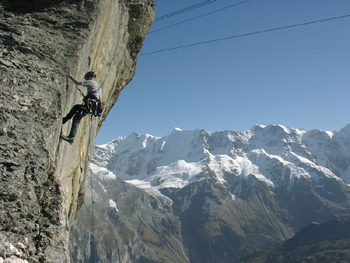 Last summer, in one of
the largest rescues in mountaineering history, more than 70 climbers were pulled
from the slopes of the Matterhorn in the Swiss Alps. Climbers became stranded
when the mountain literally began to crumble under their feet. Now, researchers
are blaming record-breaking summer temperatures in 2003 for the destabilization
of the Alps.
Last summer, in one of
the largest rescues in mountaineering history, more than 70 climbers were pulled
from the slopes of the Matterhorn in the Swiss Alps. Climbers became stranded
when the mountain literally began to crumble under their feet. Now, researchers
are blaming record-breaking summer temperatures in 2003 for the destabilization
of the Alps. Geologist Stephan Gruber installs a data-logger to measure permafrost thaw in the Alps. Increased rock falls in the Alps may be an unexpected consequence of climate change. Courtesy Stephan Gruber/Marco Peter.
In the July Geophysical Research Letters, Stephan Gruber of the University of Zurich and others link rock falls to the distribution of permafrost thaw. Permafrost is soil or rock that remains frozen all year long and can include vertical rock faces in alpine environments. Frozen water in the cracks and crevices of rock faces acts like glue, holding rocks together. When the ice melts, the rocks become extremely unstable — even more so than if the rocks were completely dry, says Michael Davies, a civil engineer at the University of Dundee in Scotland, who was not involved in the study.
From 2001 to 2002, Gruber’s team measured temperature and heat flux in rock faces at different elevations and with different aspects (for example, north-facing versus south-facing walls). Using the data, they verified models predicting where permafrost thaw was likely to be the greatest. Then, in 2003, unbeknownst to the researchers, Switzerland experienced one of the hottest summers in the past century, Gruber says. And the exceptional rock fall that summer correlated well with the researchers’ predictions for permafrost thaw — helping to verify their model.
Gruber says that increased awareness after the rock falls of 2003 refocused attention on the danger of permafrost degradation. “It changed people’s perspective,” he says. “Now companies are beginning to look where rock falls could affect infrastructure and tourism.”
Gruber and colleagues’ model may play a role in increased safety precautions. “This research will help us tell where and when a fall will take place,” Davies says. “If we know where rock falls are likely and someone is installing a cable car, for instance, we can put rock bolts into the wall before construction begins.”
The real danger, Gruber says, may be a changing climate with overall warmer temperatures and increased seasonal variability. With large spikes in temperature on top of already warm conditions, Gruber says, permafrost that may have been frozen for many hundreds or even thousands of years, such as some shaded, north-facing alpine rock faces, is now vulnerable to thaw.
Jay Chapman
Geotimes intern
Back to top

